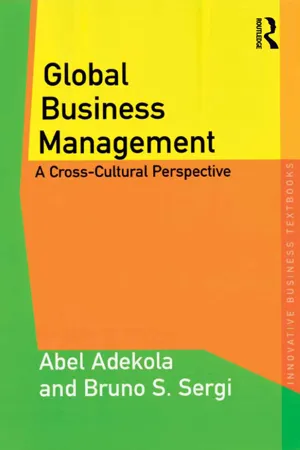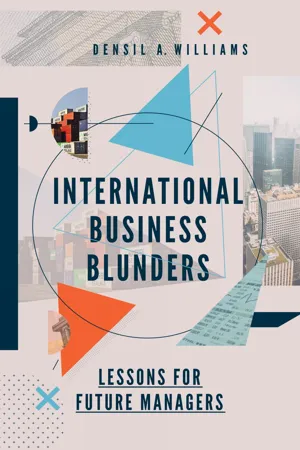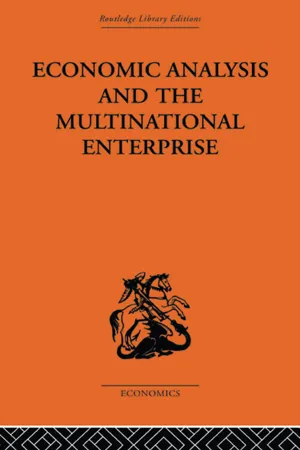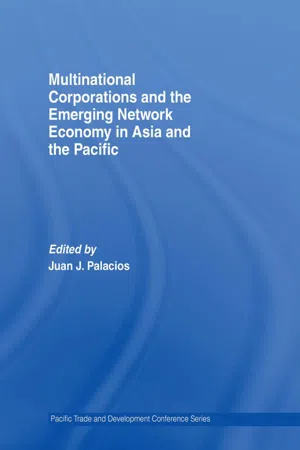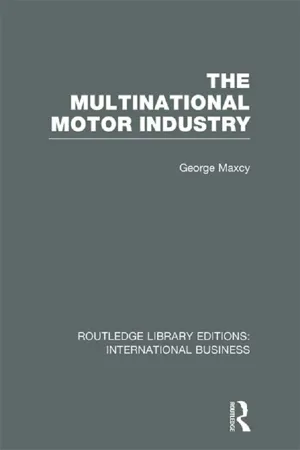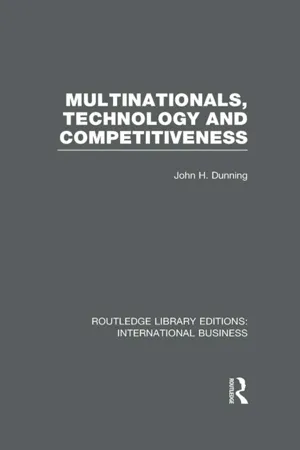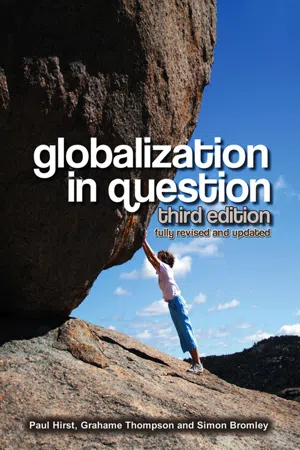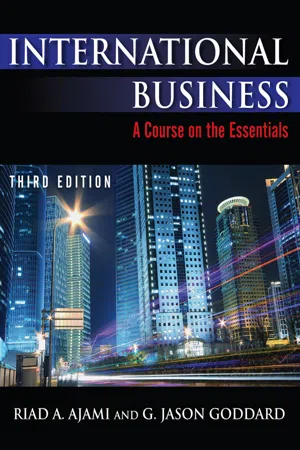Business
Multinational Company
A multinational company is a corporation that operates in multiple countries, with a centralized management system. These companies often have a global presence and conduct business activities in various locations around the world. They typically adapt their strategies to suit the specific needs and regulations of each country in which they operate.
Written by Perlego with AI-assistance
Related key terms
Related key terms
1 of 4
Related key terms
1 of 3
10 Key excerpts on "Multinational Company"
- eBook - ePub
Global Business Management
A Cross-Cultural Perspective
- Abel Adekola, Bruno S. Sergi(Authors)
- 2016(Publication Date)
- Routledge(Publisher)
Chapter 3 An Introduction to Multinational Enterprises The Oxford English Dictionary (OED) Second Edition defines multinational as relating to, consisting of, or involving several or many countries or nationalities. It is of a company or other organization, operating in several or many countries. The OED goes on to define enterprise, the noun, as a design of which the execution is attempted, a piece of work taken in hand, a bold, arduous, or momentous undertaking. Enterprise, as a verb, is defined as to take in hand (a work), take upon oneself (a condition), attempt or undertake (a war, an expedition, and so on), run the risk of or venture upon (danger) (Oxford English Dictionary, 1989). As shown, a multinational enterprise is literally an attempt of several countries or nationalities to venture or take in hand the organizations and operations in a bold way. This chapter will explain multinational enterprises, their purpose, importance, and future. Multinational enterprises (MNEs) have many of the same activities and functions that ordinary non-multinational enterprise companies have. However, many factors make these activities and functions significantly different. When looking at multinational enterprises in conjunction with other businesses, the three-cost strategy framework, fixed costs, distance costs, and location costs still works. You can still analyze your business and that of your competition by examining the framework. However, when it comes to competing internationally, things change. A multinational enterprise is a company that owns a significant part of and operates facilities in nations other than the one in which it is based. As noted in Chapter 2, there are three stages companies go through to become global companies. The first stage is when companies simply move goods internationally. This is what is widely known as importing or exporting goods. In this stage, there is no production being done in the foreign countries - eBook - ePub
International Business Blunders
Lessons for Future Managers
- Densil A. Williams(Author)
- 2019(Publication Date)
- Emerald Publishing Limited(Publisher)
Noted business historian Mira Wilkins observed that the definition of the MNE is a source of confusion. Wilkins (2001) argued that in the phrase, ‘international business’, ‘international’ being an adjective and ‘business’ being a noun, the noun business can be defined as an activity or as a firm. If it is an activity, then the concept of international business cannot be used interchangeably with the MNE. However, if it is construed to be a firm, then the MNE and international business can be used interchangeably. Generally, international as an adjective is normally substituted with words such as global, multinational and transnational, which then clarifies the noun, business, to mean a firm. As such, the phrase, MNC becomes synonymous with international business. If the noun business, however, connotes an activity, then using the adjectives to modify it would not be tantamount to international business (Wilkins, 2001, p. 5).The interpretation from Wilkin’s line of argument, it appears, seems to be that an international activity can take many forms. For example, humanitarian efforts to provide medication and food to children in war-torn countries is an activity. However, this would not be classified as international business. As such, one could not call this effort a MNC. A firm, it appears, to those researchers who make the subtle distinction, connotes something more than an activity. It has a mission and a vision towards increasing shareholder value. Put differently, the firm has a profit motive while an activity can have a profit or non-profit motive.While the debate on the subtle definitions of business being a firm or an activity rages on, the majority of scholars have settled on business to mean, a firm, company or corporation. Therefore, the multinational firm and international business become synonymous and are used interchangeably. The most important variable in defining the MNC is that it has a headquarters in one country and then extends itself into other countries by not merely selling to unaffiliated firms but has a presence, by internalising its operations irrespective of how small that presence is (Wilkins, 2001, p. 6).The next big issue that business historians contend with is the evolution of the modern MNE. In the field of international business, scholars have noted that the evolution of the modern multinational is a post-World War II phenomena (Peng, 2004). A significant amount of work has chronicled the history of American investments overseas, as well as the spread of foreign direct investments (FDIs) from other home countries besides the United States, with the view that these investments started after World War II (Wilkins, 1974). However, business historians such as Alfred Chandler, Mira Wilkins and others have shown that the evolution of the modern MNE dates back roughly to the last half, or even more accurately, the last third of the nineteenth century. They have also noted that despite a detailed look at the MNE since the latter part of the 1800s, there were earlier operations of firms which shared certain features that are similar to the modern enterprises. Similarly, economic historians such as Hilary Beckles (2013) argue that the enterprises which participated in transatlantic slave trade were carrying out international business from long before the post-World War II era. As such, the conclusion that the modern multinational is a creation of the post-World War II era is not a correct historical fact. - eBook - ePub
- Professor John H Dunning, John H. Dunning(Authors)
- 2014(Publication Date)
- Routledge(Publisher)
There are three near relations to the multinational enterprise. These are:- The national enterprise which operates production units in different parts of the nation state in which it is incorporated, i.e. the multi-regional national enterprise. Like it, the multinational enterprise owns income-generating assets in more than one location and uses these, together with the locally owned resources to produce goods and services. As the affiliates of multi-regional national enterprises possess certain advantages over their local competitors, due inter alia to their being part of a larger economic unit, and the opportunities for specialisation this confers; so do multi-national companies enjoy similar benefits over national companies. But, unlike the multi-regional national enterprise, the Multinational Company owns and operates its assets and controls the use of its inputs in different national states, each of which, are sovereign political units.
- The national firm which produces in the country in which it is incorporated but exports part of its output,5 i.e. the international trading firm. Like it, the multinational enterprise sells its output across national boundaries, thereby introducing an element of openness and interdependence into both the exporting and importing economies. Unlike the international trading firm, however, its activities involve a transference of income-generating assets, and part of its trade is not between independent economic agents, at arm’s-length prices, but within the same enterprise, at transfer prices, which, in so far as it is possible, will be fixed to serve the interests not of any particular affiliate but of the enterprise as a whole.
- The national producing firm which exports part of its factor inputs, e.g. material or human capital. Like it, the multinational enterprise exports income-generating assets; but, unlike it, supplies these as a package deal and maintains control over the use made of them.
- Juan J. Palacios(Author)
- 2008(Publication Date)
- Routledge(Publisher)
Although transnational production networks potentially have a global reach, they tend in practice to take hold in regional settings. A distinct international division of labour is established in each region – mainly in North America, Europe and Pacific Asia (‘the Triad’) – with lead firms based in high-cost countries coordinating operations in affiliates based in low-cost locations (Ernst 1994; Linden 1998).MNCs thus play a dominant role not only in the formation and shaping of cross-border production networks but also in the globalisation of world production. As early as the mid-1990s the United Nations Conference on Trade and Development (UNCTAD) observed that globalisation ‘is ultimately the product of decisions taken by [global] firms’ (UNCTAD 1994: 158). A decade later, Medard Gabel and Henry Bruner, both members of the ‘Mapping the Multinational Corporations Project’, whose advisory board includes some of the most noted specialists on MNCs,4 went further to assert that ‘Globalisation and global corporations are as interrelated as the chicken and the egg’ (Gabel and Bruner 2003: x).In effect, MNCs have been one of the most influential players on the international economic stage at least over the last half a century. Their influence is not only economic but also technological, political, social and even cultural, so much so that they have been regarded by observers like Gabel and Bruner as the leviathans of our time. Major multilateral economic institutions like the World Bank and the International Monetary Fund, international agencies like UNCTAD and the United Nations Industrial Development Organization (UNIDO), major international non-governmental organisations, and large regional development banks (for example, the Inter American Development Bank and the Asian Development Bank) are highly influential but tend to play a coordinating, supporting role.- eBook - ePub
- Peter Drucker(Author)
- 2013(Publication Date)
- Routledge(Publisher)
The term multinational is of very recent coinage: it was unknown even twenty years ago. It fits the nineteenth-century structure — Singer Sewing Machine — much better than it fits the development to which it is being applied. Singer Sewing Machine was truly “multinational.” But the pharmaceutical company that integrates eleven drug-manufacturing plants, seven intermediate plants, and four research labs into sales of many drug products in eighty countries is not multinational. It is “transnational.” And so is the automobile company that integrates plants in Germany, Britain, Mexico, and Canada for a sale in the U.S., or the commercial bank that integrates banking resources in eight countries to raise money in a ninth country to finance a development in a tenth country. National boundaries are no longer determinants. They are restraints, obstacles, complications. What determines is the reality of a non-national common market. The opportunities — but also the problems — of the so-called multinational lie not in its being multinational, that is, in its doing business in many countries. They lie in its being transnational, that is, based on the reality of a common world market — common in its demands, in its vision, and in its values.This means that it is not factors of production that explain the new multinational, inform its strategy, and explain its behavior. It is factors of demand. It is demand that exerts the pull. The multinational business is in every case a marketing business.The Problems of Strategy
What distinguishes the multinational corporation from any other business is that it faces both internal and external diversity. It has to create unity within its own managerial organization and yet do justice to the diversity of peoples, nationalities, and loyalties within it. And it has to create a unified business that can optimize factorial costs and factorial advantages within a common world market and yet live in peace — or at least without constant conflict — with a multitude of separate political sovereignties.The pharmaceutical company mentioned earlier needs a strategy for the company as a whole. But each of the eighty-odd national companies needs one as well. So do the manufacturing units, the units making intermediates, and the research laboratories. Each has to be managed as an autonomous business with its own objectives, its own priorities and plans, its own profit and loss responsibility. - George Maxcy(Author)
- 2013(Publication Date)
- Routledge(Publisher)
PART ONEECONOMICS AND THE MULTINATIONAL ENTERPRISEPassage contains an image
1THE NATURE OF THE MULTINATIONAL ENTERPRISEThe essential and unique characteristic of the manufacturing multinational enterprise (MNE) is that it owns and/or controls resources engaged in production outside the country in which it is based. Because of this its behaviour is likely to be different from that of a purely national company. But this feature, by itself, is not sufficient to account for the great interest and concern aroused by MNEs since the second world war, rather it is the combination of multinationality and certain other characteristics, which may be found in national and multinational firms alike, that is responsible. Paramount among these is the huge size of the typical MNE. In the motor industry a dozen giant enterprises produce the great bulk of the world’s output of vehicles outside the Communist countries and, for the year 1976, their consolidated sales ranged from General Motors’ 47 billion (thousand million) dollars to Volvo’s 3.6 billion.1 Related to size is the oligopolistic structure of the industries from which most MNEs have originated, together with the emphasis on product differentiation and extensive advertising associated with such an industry structure. Of great importance also is the fact that MNEs are generally found in industries dominated by advanced technology. They account for the bulk of research and development expenditures in these industries and they are the major innovators.2 Much of their economic power is derived from this. In short, MNEs are typically very large organisations owning and/or controlling an international network of productive resources, and operating in high-technology industries, oligopolistic in structure.That network is normally established by means of direct investment abroad by the parent company and involves the transfer of a ‘package’ of resources – technical and managerial knowledge along with capital. Control over the use of these resources remains firmly in the hands of the parent company, located in a particular country, managed and owned predominantly by citizens of that country. The MNE may straddle the globe, employ hundreds of thousands of people from many lands; nevertheless, it has a nationality. It is American, British, German, Japanese or whatever.3- John Dunning(Author)
- 2013(Publication Date)
- Routledge(Publisher)
Chapter Two
International Business in a Changing World Environment
INTRODUCTION
In this chapter, we consider some aspects of the interface between international business - primarily in the guise of the MNE - and the governments of the countries which are host to its activities, within a changing world economic and political scenario. The chapter sets out to examine why, how and in what ways this interface has been shaped by, or has shaped, the events of the past twenty-five years, and speculates a little about the prospects for the remainder of the twentieth century.ANTECEDENTS OF THE MNE
The Multi-Plant Enterprise
The MNE is the modern equivalent of the multi-plant domestic enter prise which dates back more than a century. In particular, the years following the Civil War saw the transformation of many regional American corporations into national corporations, and the emergence of multi-plant establishments, under the same ownership, in different parts of the USA. And it is, perhaps, worth recalling that the spread of Northern US companies into the south was regarded by some observers at the time with almost the same suspicion and unrest as that exhibited more recently by some Southern (developing) countries towards inter national corporations from the Northern hemisphere.A useful starting point to any understanding of the modern MNE is to regard it as an extension of the domestic multi-plant firm (Caves, 1982). In both instances, a company seeking to service a market beyond its immediate catchment area must have some kind of advantage, which we shall call an ownership-specific advantage (Dunning, 1981, 1988) over and above that possessed by its competitors, or potential competitors, producing in that market. In both instances, too, it must be more profitable to supply the market from a foreign, rather than a domestic, location, and for the firm possessing the advantage to use it itself rather than sell the right to do so to other firms.- eBook - ePub
International Marketing
Strategy and Theory
- Sak Onkvisit, John Shaw(Authors)
- 2009(Publication Date)
- Routledge(Publisher)
MNC is not a one-dimensional concept. There is no single criterion that proves satisfactory at all times in identifying an MNC. Varying definitions are not necessarily convergent. As a result, whether or not a company is classified as an MNC depends in part on what set of criteria is used.Definition by size
The term MNC implies bigness. But bigness also has a number of dimensions. Such factors as market value, sales, profits, assets, and number of employees, when used to identify the largest multinationals, will yield varying results. While Business Week magazine focuses on market value, Forbes magazine ranks the world’s largest public companies by using a composite ranking of sales, profits, assets, and market value. As measured by stock market valuation, the world’s top five companies are ExxonMobil, General Electric, Microsoft, Gazprom, and Citigroup.11 Gazprom, a Russian entity with market capitalization of $256 billion, is the world’s largest natural gas company whose 49 percent of the shares were only listed for the first time in December 2005. Table 1.1 shows the global leaders based on the number of employees. Table 1.2 , in contrast, shows the world’s largest banks based on market value.In the case of the World Investment Report of the United Nations Conference on Trade and Development (UNCTAD), it ranks transnational corporations (TNCs) by their foreign assets and spread index (see Tables 1.3 and 1.4 ).Many multinational corporations are indeed large. Ownership of foreign assets is highly concentrated since half of the total is owned by just 1 percent of TNCs. Interestingly, multinationals’ overseas investment has progressed to the point where sales generated by them outside their country of origin even exceed the world trade volume (total world exports).One criterion to assess whether multinational firms are global is their penetration level of markets around the world. Very few of the 500 largest MNCs are successful globally. Out of 380 firms for which geographic sales data are available, 320 of them have an average of 80.3 percent of total sales in their home region. As such, in terms of market coverage, these companies are more regional than global.12 - eBook - ePub
- Paul Hirst, Grahame Thompson, Simon Bromley(Authors)
- 2015(Publication Date)
- Polity(Publisher)
It is the typology by Bartlett and Goshal (1989) of different forms of international company that has struck a chord with those researchers concentrating on company form and the analysis of company strategy. Building on their suggestions, it is possible to draw a conceptual distinction between four organizational types of global business, using their labels of ‘multinational’, ‘international’, ‘global’ and ‘transnational’ respectively. The outline characteristics of these types of companies are:1 those that build on a strong local presence through sensitivity and responsiveness to national differences (‘multinational companies’) 2 those that exploit parent company knowledge and capabilities through worldwide diffusion and adaptation (‘international companies’) 3 those that build cost advantages through centralized operations on a global scale (‘global companies’)4 those that disperse their activities to relatively independent and specialized units seeking to be globally competitive through multinational flexibility and worldwide knowledge development and learning capabilities (‘transnational companies’).Thus, broadly speaking, these forms proceed from a more national focus to a wider transnational one. An attempt to test empirically for these organizational types found that the most common remained the multinational type, while the least common was the transnational type (Leong and Tan 1993). This finding set the trend for further empirical work that cast doubt on the full development of the global economy and the transnational type of corporate form: the majority of ‘international’ firms still remain tethered to a definite national country base, confirming the analysis above.Technology
The issue of innovation and the role of technology is another dimension along which the process of company internationalization is often thought to be rapidly proceeding, and it is used to bolster the argument about the globalization of company activity. Again, there is little systematic company-based evidence about how much of this remains focused on the parent country rather than overseas, but what evidence is available broadly supports the conclusion that this type of activity remains far from fully globalized. For instance, in their analysis of the international distribution of R&D laboratories of 500 major firms, Casson, Pearce and Singh (1992) found some degree of interdependency, but it varied greatly according to the parent countries of firms. Firms from the Netherlands, Switzerland, West Germany and the UK showed significant foreign orientation (the international to home ratios of laboratories for companies from these countries were all over 60 per cent), while the other nine countries or groupings studied showed considerably lower ratios (the average ratio was 39 per cent). The dominant country in terms of numbers of companies and laboratories, the USA, had a ratio of only 31 per cent, confirming it as a relatively ‘closed’ country on this measure. Countries such as Japan and Sweden remain very closed. In addition, papers by Cantwell (1992), Patel and Pavitt (1992) and Patel (1995) take other measures of technological activity: in patent registration, for example, no more than 10 per cent of patents granted to international firms by the US patent office originated from foreign subsidiaries, and the share of patents coming from foreign subsidiaries did not substantially increase between 1969 and 1986, or between 1986 and 1990 (based on the analysis of 686 of the world’s largest manufacturing companies). The home territory remained the dominant site for the location of this form of R&D activity, reinforcing the local innovation system. - eBook - ePub
International Business
Theory and Practice
- Riad Ajami, Jason G Goddard(Authors)
- 2014(Publication Date)
- Routledge(Publisher)
These developments in the past fifty years provide a fascinating area of study for the student of international business because it was a time of unparalleled growth and activity. The trend is likely to continue upward, with increases in the flow of goods, capital, investments, and labor across national borders, plus the growth of truly global industries and corporations.DISCUSSION QUESTIONS
1. Why has international business become so important in today’s environment?2. What are some of the reasons that corporations choose to develop international operations?3. What differentiates the modern multinational corporation from the import-export firm?4. What factors makes international business more complex than conducting domestic businesses?5. Obtain the annual report of a large multinational corporation and identify the scope of its international operations and the countries in which it currently operates.6. What are some of the conflicts that may occur between a multinational corporation and the local government hosting the multinational?7. How can increases in world trade affect the owners of small businesses in your hometown?8. How can studying international business increase your understanding of the world around you?NOTES
1. United Nations Conference on Trade and Development, Statistics Database, 2011.2. Wilkins, Emergence of the Multinational Enterprise.3. Perlmutter, “Tortuous Evolution of the MNC.”4. US Department of Commerce, Bureau of International Commerce, Trends in Direct Investment Abroad by U.S. Multinational Corporations , 1975.5. Citigroup, Citigroup 2003 Annual Report , 2003.6. Citigroup, Citigroup 2011 Annual Report , 2011.7. Sony, Annual Report 2003 , 2003.8. Sony, Annual Report 2011 , 2011.9. Nestlé, “General Information,” Management Report 2003 , 2003.10. Nestle, Annual Report 2011, 2011.11. Some texts use the term “proprietary technology” for technology that has been patented by a firm.12. World Bank, “World Development Indicators,” 2012.13. United Nations Conference on Trade and Development, World Investment Report, 2004.BIBLIOGRAPHY
Citigroup. Annual Reports
Index pages curate the most relevant extracts from our library of academic textbooks. They’ve been created using an in-house natural language model (NLM), each adding context and meaning to key research topics.
Explore more topic indexes
Explore more topic indexes
1 of 6
Explore more topic indexes
1 of 4
